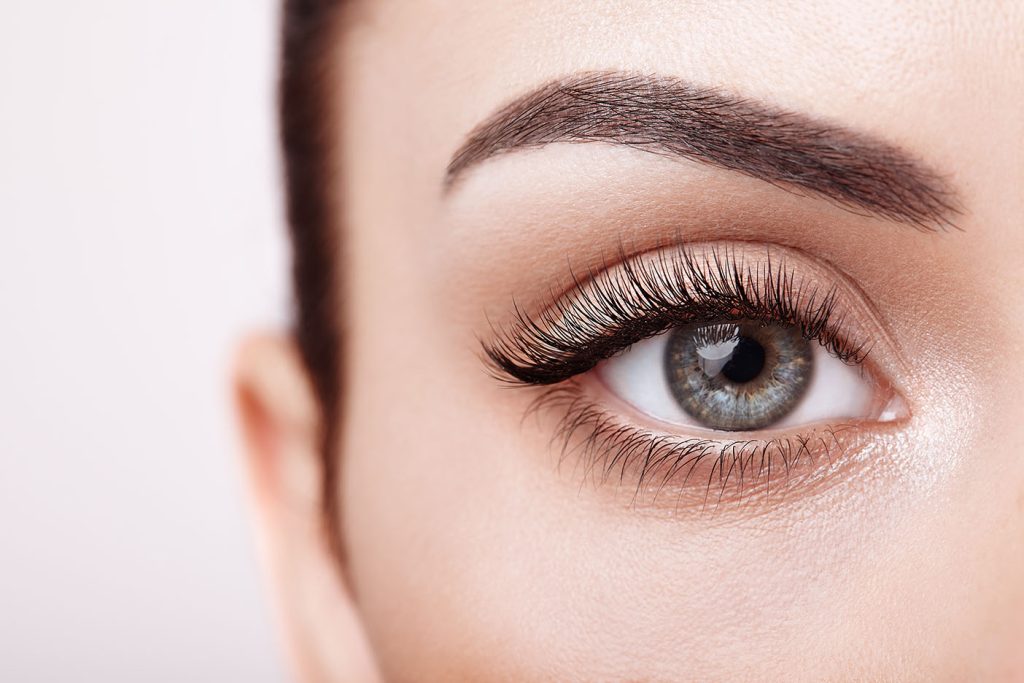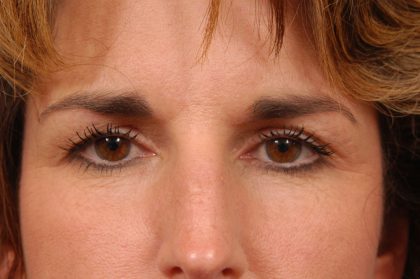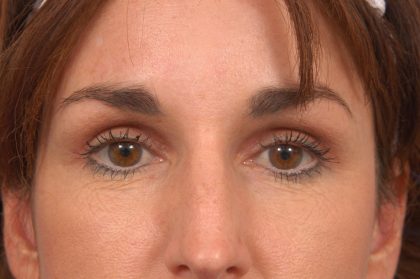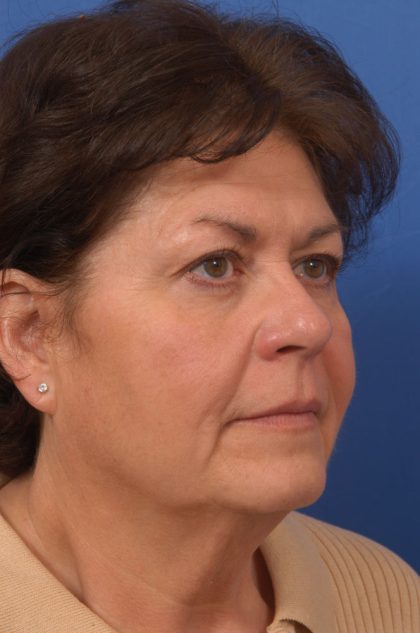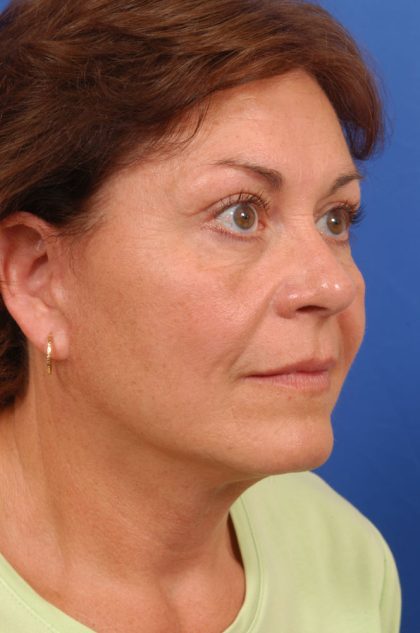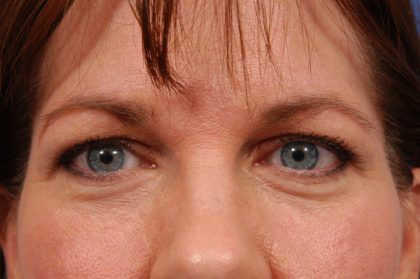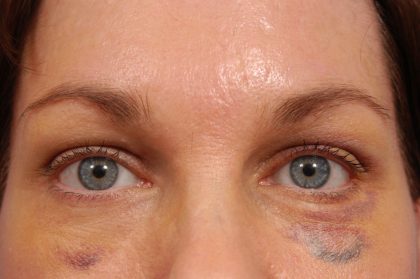Blepharoplasty
Offered at our convenient location in Denver
A blepharoplasty, or eyelid lift, is a surgical procedure that removes excess skin from the eyelid area. Eyelid sagging, known as ptosis, can become a significant problem as facial skin quality decreases with age. And, finding a way to resolve more severe cases can be virtually impossible without surgical intervention. There is no quick fix for drooping eyelid skin. This is because facial skin loses vital components over time, and eyelid skin is particularly delicate and prone to structural decline.
Also called blepharoptosis, ptosis is the medical term for eyelid sagging. Some people may have naturally hooded eyelids, but ptosis is more severe, and can even affect a person’s field of vision. A patient may wish to address sagging eyelids for purely cosmetic reasons, or to improve vision impacted by redundant skin. Whatever the needs of the patient, the procedure requires considerable skill to ensure the right amount of tissue is removed.
Millard Plastic Surgery Center offers blepharoplasty procedures to residents of the wider Denver area and beyond from the country’s leading plastic surgeons. Solve eyelid sagging, receive expert facial rejuvenation advice, and find out more about the blepharoplasty procedure by calling our Englewood location at (303) 792-5665, or by completing our simple online inquiry form.
Contents
Before and After Photos
How Eyelids Change with Age
Changes in our eyelids affect our appearance. The eyelid tissues are made up of skin, oil glands, connective tissue, muscle, and thin fat pads. But, like other areas of the face and body, they are affected by age-related tissue changes. In some cases, significant tissue change can even affect our vision, particularly if tissue sagging has progressed. If you have noticed your eyelids feeling heavier, your eyes strain to see, and you appear more aged and tired-looking in the mirror, you may have some level of eyelid ptosis.
Why Do My Eyelids Sag?
Eyelid ptosis can occur for a number of reasons. Congenital ptosis is something a person is born with, while acquired ptosis has a number of potential causes.
- Tissue Aging
- Trauma/Prior Surgery
- Medical Conditions
- Muscle Weakness
- Nerve Damage
Time affects all of us differently. And for some people, signs of facial aging show around their eyes the most. Drooping eyelids, tissue loss in the temples, under-eye hollowing and crow’s feet are all common complaints in patients seeking facial rejuvenation. These, and other tissue changes occur because the aging process changes key components in our bodies.
Collagen and elastin are proteins that make up the extracellular matrix around skin cells. The body produces less of both over time, and cannot replenish these lost elements fast enough. This affects the skin’s structural resilience and elasticity. As well as weakened skin, eyelid ptosis can be compounded by nerve damage or weakness in the muscles responsible for lifting the eyelids.
Useful Medical Terms
- Blepharoptosis/Ptosis – eyelid sagging
- Epiphora – watery eyes
- Ophthalmalgia – eye pain
- Blepharitis – inflammation of the eyelids
- Dermatochalasis – excess eyelid skin
- Myasthenia Gravis – a condition causing muscle weakness in the eyelids
- Neurogenic Ptosis – sagging caused by nerve damage
- Steatoblepharon – “puffy” fat in the upper and lower eyelids
Benefits of Blepharoplasty
Blepharoplasty surgically manipulates the eyelids for aesthetic or functional reasons. And, according to the American Society for Aesthetic Plastic Surgery, it’s the fourth most performed cosmetic surgery in the United States. (1) So what are the advantages of the procedure?
- Removes redundant eyelid skin
- Achieves a more youthful eye appearance
- Refreshes and renews tired-looking eyes
- Personalized to individual patient needs
- Addresses the upper and/or lower eyelids
- Improves impaired field of vision
- Reduces eye irritation caused by sagging skin
There are no permanent non-surgical solutions to eyelid sagging. A blepharoplasty procedure is the only effective way to remove redundant eyelid tissue, making it the first choice for patients struggling with eyelid ptosis.
Don’t wait. Book your personal consultation at Denver’s leading plastic surgery center at (303) 792-5665 for more information about rejuvenating eyelid lift procedures.
Candidates
The most suitable candidates for blepharoplasty are patients seeking functional or aesthetic correction of eyelid sagging. The procedure is particularly helpful if your vision is affected, and your daily life is impacted because your field of vision has gotten worse because of excess lid tissue. Upper and/or lower-lid blepharoplasty is also an effective treatment for steatoblepharon (prominent fat pads). (2)
Blepharoplasty may not be suitable in the following circumstances.
- If you have a bleeding/blood clotting disorder
- If you have been diagnosed with dry eye disease
- If you have an inflammatory skin condition (e.g. psoriasis, eczema)
- If you have a serious health condition (e.g. heart disease)
- If you have previously had more than one eyelid surgery
Surgery to remove unwanted eyelid skin can make a huge difference in your facial appearance, and improve your quality of life. See what it can do for you by arranging a personal consultation at Millard Plastic Surgery Center. Meet our staff here!
Personal Consultation
We will plan your blepharoplasty procedure extensively. You will speak to one of our plastic surgery experts to discuss the problems that have brought you to us. In this, and future sessions, we may conduct vision tests, an assessment of ptosis severity, and a lid laxity assessment. We will also ask you to give us health and medical history details, to ensure eyelid surgery is right for you.
Preparation
- Stop taking anti-inflammatory medications. These include over-the-counter pain-relievers like Motrin and Alieve. You should also stop taking anti-inflammatory supplements such as vitamin E. This is because these medications and supplements affect blood clotting, and may increase bruising.
- Stop smoking at least two weeks before your planned surgery date. The chemicals in cigarettes can slow healing, and reduce circulation in the treatment area.
- Arrange transportation to- and from our surgery center. The effects of sedation and anesthesia will mean you won’t be able to drive yourself.
Blepharoplasty Procedure
Where indicated, your surgeon may address upper and/or lower eyelids in a single procedure, or separate procedures depending on your treatment plan. Before surgery, your doctor will take the necessary measurements and ask you to raise your eyebrows as high as you can, while keeping your eyes closed. This is to demarcate the excision points.
No two blepharoplasties are exactly the same. A surgeon must consider a patient’s individual features carefully, to ensure the right amount of tissue is removed in each case. The most commonly performed procedures include excision (removal) of a wedge of skin in the upper eyelids. The wedge excision method runs along the natural crease of the eyelid and removes a precise amount of tissue to eliminate sagging. (2)
Eyelid Lift Customization
The blepharoplasty is a highly individualized surgery. Some approaches place incisions on the outside of the lid, while others access tissues via the inner lid surface. A surgeon may alter the position of numerous muscles that control eyelid movement, as well as the removal of drooping skin. In others, part or all of the fat pad in the lid is removed. And in lower lid blepharoplasty, the most varied and versatile procedure, there may be changes to skin, fat, and the lid-cheek junction for the most aesthetically pleasing results. (2)
Once the precise amount of tissue has been removed, your surgeon will suture the incisions closed. We will monitor you in our recovery room until the effects of your anesthesia wear off. You may then leave with the person you have arranged transportation with. If you receive non-absorbable sutures, you will return to have them removed in roughly one week.
Recovery
Our patients follow a thorough, and effective recovery plan after a blepharoplasty procedure. Important aspects of this plan include the following.
- Avoid wearing contact lenses for roughly two weeks.
- Take prescribed pain medications and antibiotics exactly as prescribed.
- Don’t take part in any activities that require excessive straining (e.g. exercise, heavy lifting) for at least two weeks.
- Resolve localized swelling and discomfort with cold compresses.
In the first stages of blepharoplasty healing there will be swelling, bruising, and discomfort. It is normal to expect some swelling in the upper third of the face. Most patients will only need to arrange a week’s absence from work, although you should ease into more vigorous activities slowly, waiting a further week.
Results
Once swelling goes down and your eyelids are healed, you will see your initial results. It can take a few weeks more for your final results to be fully realized. Most patients will be able to see their beautiful, fully settled eyelids after 4-6 weeks.
Cost of Eyelid Lift in Denver, CO
The cost of blepharoplasty surgery varies according to patient needs. We will discuss the cost of your treatment following a detailed examination and a review of your needs at your consultation. Qualified candidates may wish to finance their procedure with Patient Fi or CareCredit. Book your appointment to discuss eyelid surgery at Millard Plastic Surgery Center by calling our Englewood office at (303) 792-5665, or by completing this form. Email inquiries to [email protected].
Patient Fi provides an “easy-to-use” online program that has strong approval rates, and interest rates as low as 7.9%!
- No impact on credit rating with soft pull
- No prepayment penalty
- No hassle application
- No application or annual fees
- Wide selection of payment plans to fit your budget

Read more about plastic surgery in Denver by reading our informative blog.
FAQ
Why do my eyes look so tired all the time?
Sagging tissues around the eyes in the upper and lower eyelids can make you look perpetually tired. A permanent solution to eyelid sagging is a surgical procedure called a blepharoplasty, or eyelid lift.
How long does eyelid surgery take?
It depends on individual patient requirements, and what is indicated in their treatment plan. Most blepharoplasty procedures are relatively short, between 1-2 hours. If upper and lower eyelid surgery is required, the procedure may take longer.
Does eyelid surgery need general anesthesia?
Not necessarily. Blepharoplasty procedures can be conducted safely under local anesthesia or conscious sedation. In fact, recovery time can be more comfortable, and shorter, with non-general anesthesia options like Exparel, an extended relief analgesic medication. Discuss anesthesia preferences with your surgeon at your consultation to find out what is available to you.
References
- Alghoul M. Blepharoplasty: Anatomy, Planning, Techniques, and Safety. Aesthetic Surgery Journal. 2018;39(1):10-28. doi:10.1093/asj/sjy034
- Rebowe RE, Runyan C. Blepharoplasty. PubMed. Published 2022. Accessed January 17, 2023. https://www.ncbi.nlm.nih.gov/books/NBK482381/
